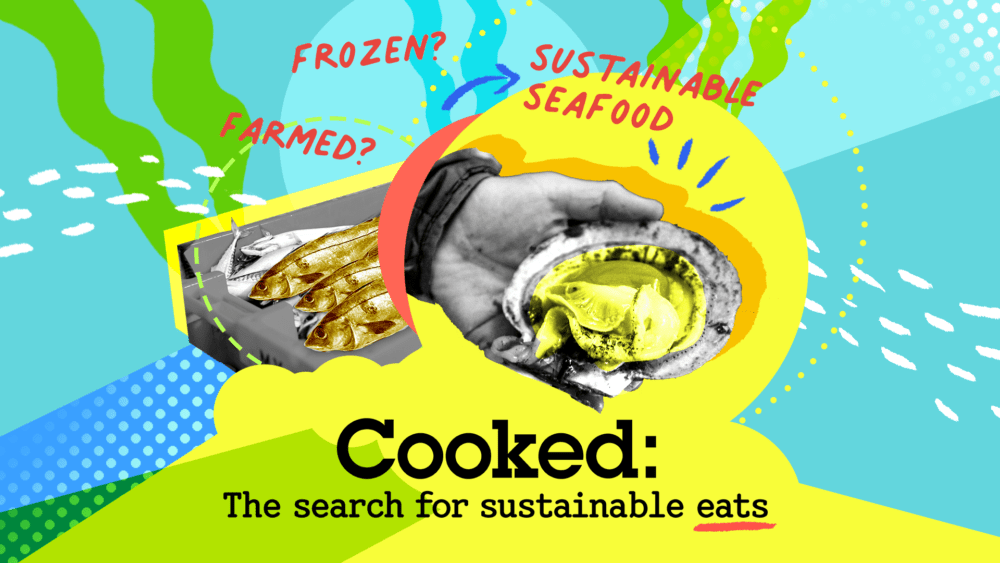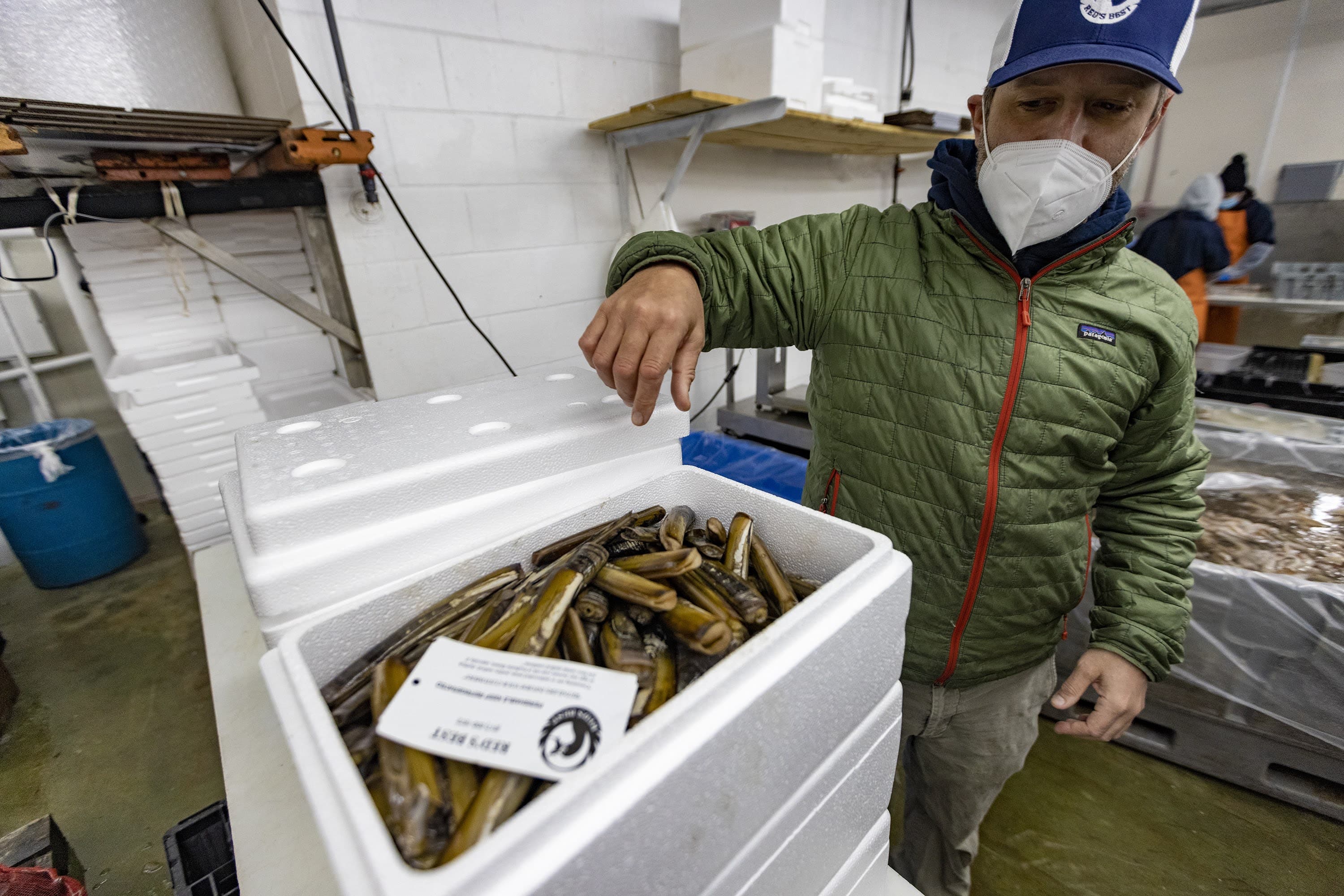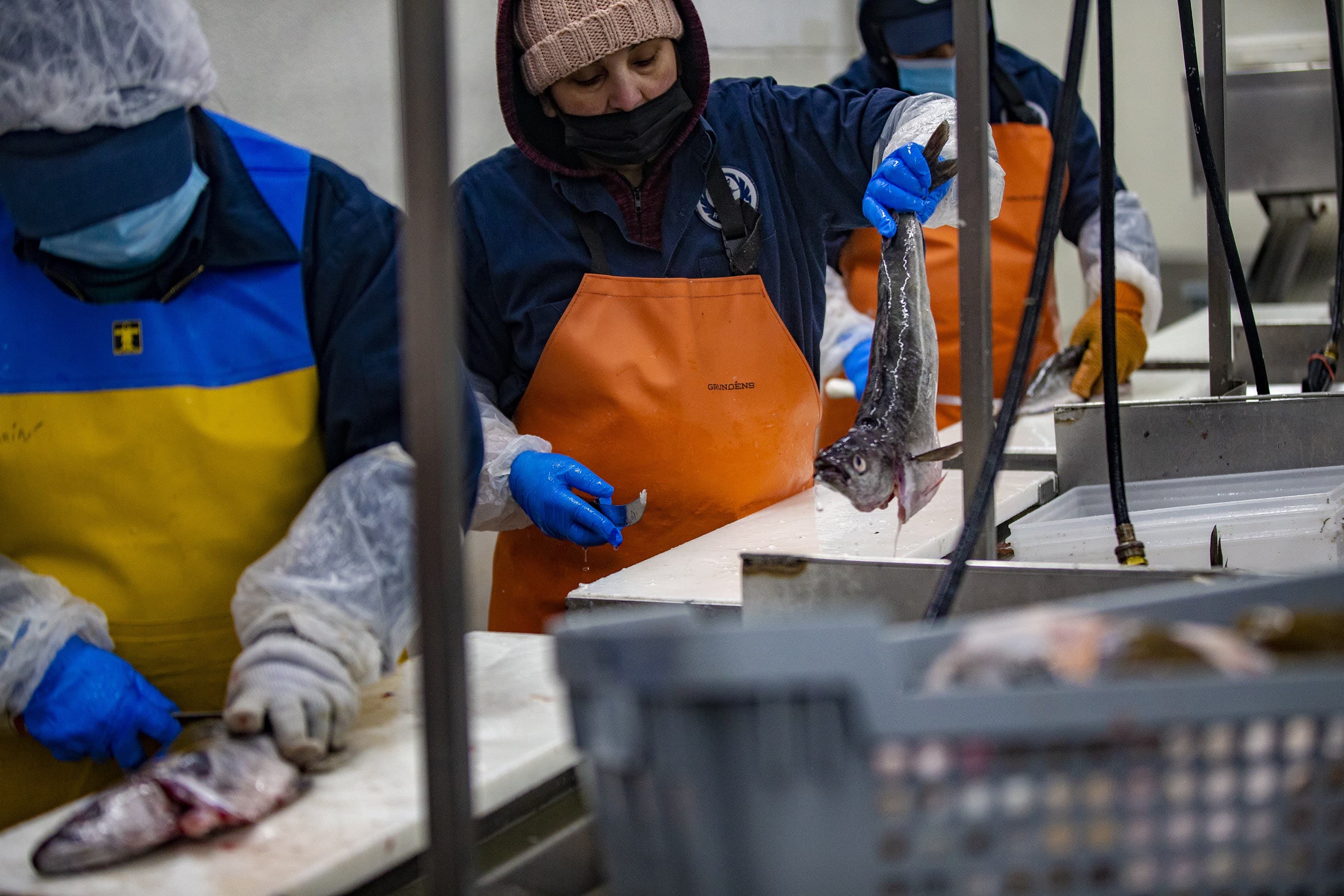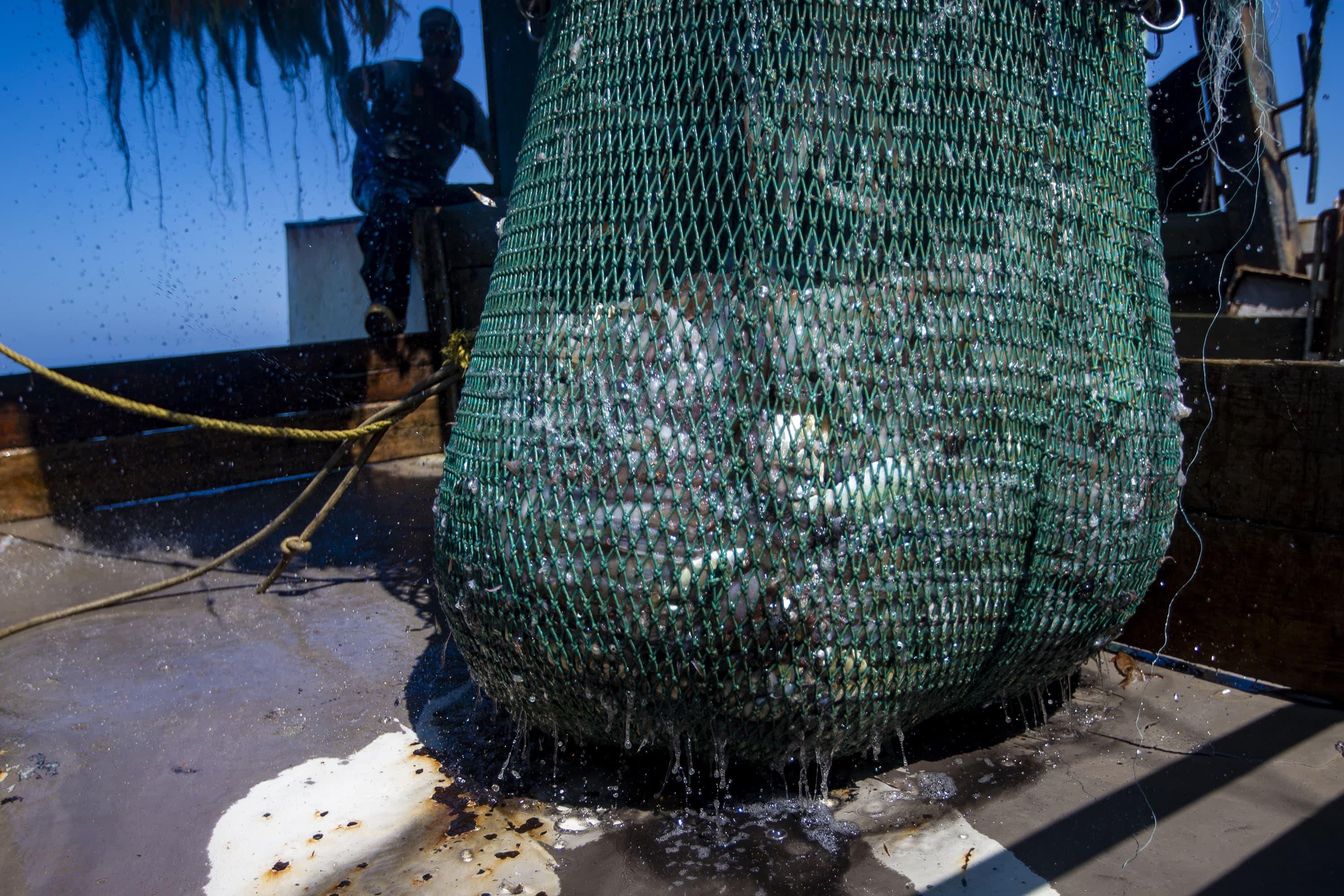Advertisement
Cooked: What makes seafood sustainable?

This is an excerpt from WBUR's Cooked newsletter. Sign up to understand how to reduce your impact on climate change and take actionable steps so YOU can make a difference.
Jared Auerbach reached into a pile of long, skinny razor clams, pulled one out and cracked it open.
Uh oh, I thought.
We were only 20 minutes into the interview and I had already eaten two raw scallops. They were delicious, like butter. But I was sure I’d soon be doubled over with food poisoning.

“I didn’t know you could eat razor clams,” I said. “How do you eat them?”
“What do you think my answer is going to be?” said Auerbach, gleefully slicing clam meat with his shucking knife. “Raw!”
He offered the knife, a flap of clam flesh dangling off the blade.
I ate it. It tasted like the ocean. (And no, I didn’t get sick.)
Following Auerbach through the packing floor of his seafood company, Red’s Best, is like chasing a kid through a candy shop — albeit a candy shop with buckets of monkfish livers, trays of squid tentacles and 50-pound bags of scallop meat.

Headquartered on Boston’s Fish Pier, Red’s Best buys more than 10 million pounds of seafood directly from hundreds of local fishermen every year, Auerbach said. The company supplies seafood to Harvard, Brown and UConn, as well as Beth Israel Hospital and Rhode Island public schools.
The morning I visited, I saw locally caught pollock, halibut and tuna. There were soft-shell clams, blood clams, razor clams and surf clams. They had black sea bass, Boston mackerel and other seafood that I had never, ever seen in a local grocery store.
That’s weird, right?
In my neighborhood big-chain grocery stores, I’ve seen fish from New Zealand, Thailand, Indonesia, Norway, Canada, Chile, China, Columbia and even Idaho. Hardly anything comes from local waters except shellfish.
That’s because American grocery stores sell mostly cheap, familiar fish.
“People are buying crappy fish, and they're trying to force feed it to their kids. Like old, icky fish that doesn't have any taste,” said Melissa Marshall, who runs Cape Ann Fresh Catch, a community supported fishery in Gloucester.
What does this mean for people in New England who want to eat local, climate-friendly, “not-crappy” fish? Let’s dive in.
The Numbers Tell A Story
- Americans eat about 19 pounds of seafood per capita each year.
- The majority of fish we eat is shrimp, salmon and canned tuna.
- The largest fishery in the U.S., by volume and value, is Alaska (worth $1.7 billion), but Massachusetts ranks second in value ($679 million) and Maine is third ($578 million).
- New Bedford, Massachusetts, has the highest valued catch of any single port in the country: $451 million. That’s thanks to sea scallops, which account for 84% of the value.
- Despite this bounty, between 70 to 85% of the seafood eaten in the U.S. is imported. And when it comes to shrimp, more than 90% is imported. (More about imported fish later.)
- The bright side: More than half of U.S. consumers say they’re willing to pay more for sustainable seafood.
Deep Dive: What Makes Fish Sustainable?
To figure out whether fish is good for the planet, you need to answer three questions:
- What fish is this, and where is it from?
- How did it get to me?
- How was it caught or farmed?
We’ll take these one-by-one.
What fish is this, and where is it from?
There are a lot of fish in the sea! And the U.S. government wants to keep it that way. State and federal authorities make sure American fishing boats leave enough fish in the water to make lots of baby fish. So, while overfishing is a huge problem in many parts of the world, fish caught in the U.S. come from strictly-managed fisheries with plenty of fish.
Climate change is already affecting the region’s fisheries, with cold-water species moving north and oysters spawning earlier. But there are still abundant fish in the waters off New England and in the Gulf of Maine, including skate, haddock, hake, monkfish, Atlantic pollock and Acadian redfish, as well as Atlantic sea scallops, clams, quahogs and eastern oysters. If you see those fish on a menu or in a market, they are more likely to be local.
How did it get to me?
If you’re growing corn, a lot of the carbon footprint comes from stuff like fertilizer, pesticides and fuel. For wild-caught fish, it’s the opposite: you need boat fuel and bait, but you don’t have to feed or fertilize fish, so most of the carbon footprint happens after the catch. For fish, food miles matter more.
And some seafood travels really far, even if it is caught locally. According to NOAA, a “significant portion” of imported seafood is caught by American fishing boats, exported overseas for processing, and then returned to the U.S.
“That’s the craziest thing about it,” said TJ Peckham, head of sales for Cape Ann Fresh Catch. “We could literally go out to a seafood restaurant in Gloucester or go to the supermarket and you could buy haddock. And that haddock originally came from Gloucester, was shipped over to Asia to be processed and then shipped back.”
Any given fish may have even more stops on its itinerary, traveling by boat, plane and truck before it lands on your plate. And how it makes the journey matters. For instance, the carbon footprint of flying fish across the U.S. is about five times higher than transporting it across the entire Pacific Ocean on a freighter, according to Sam Wilding, the fisheries program manager at the Monterey Bay Aquarium’s Seafood Watch, which rates fish and other seafood by sustainability.
The Seafood Watch folks do not figure greenhouse gas emissions into their seafood sustainability ratings, by the way, but have a seafood carbon footprint calculator that you can play with.
How was it caught?
Holy mackerel, there are a lot of ways to catch fish! And some methods are better for the ocean than others.
Potentially problematic fishing gear includes:
- Large nets (“gillnets” or “trawls”) that can scoop up unwanted “bycatch” like sea turtles, dolphins, seals and at-risk fish.
- Things you drag on the ocean floor (“bottom trawls” or “dredges”) that can damage seafloor habitats.
- Cages (“pots”) that sit on the ocean floor and connect to a buoy with a long line, which can entangle whales and other animals.

These fishing methods can be used responsibly, and a lot depends on how, where and when they’re used — but it’s really hard for consumers to find this information! The Monterey Bay Aquarium’s Seafood Watch incorporates fishing methods into its sustainable fish rankings and has an easily-searchable website and printable wallet cards that rate regional fish “green,” “yellow” or “red” for sustainability. For example, it gives farmed scallops a green rating, but bay scallops caught off the coast of Massachusetts are rated “yellow” for possible concerns about dredging and bycatch, even though Seafood Watch says the fishery is well-managed.
The ratings are very influential; places like Whole Foods and Red Lobster follow their guidance on what seafood to buy.
This is where the discussion gets a little heated. Seafood Watch recently announced it was “red-listing” American lobster because of the entanglement danger to right whales. Listings like this don’t always sit well with our local seafood industry.
“You can't paint the ocean red, yellow and green,” says Laura Foley Ramsden, a self-described “fourth-generation fishmongress” at the Foley Fish Company in New Bedford. “I know retailers want to have that ‘Good Housekeeping’ seal, but it's more complex than that,” she said, adding that guidelines created by a group on the other side of the country don’t always make sense for New England waters.
How was it caught?
Farmed fish — seafood raised in ocean pens, shallow pools or land-based tanks — is a mixed bag. It can be an environmentally and economically sound way to raise a lot of healthy fish, or an ecological disaster with exploited workers and sickly fish. So, you really have to do your homework (sorry) and research individual farms and types of seafood.
The good news: this guide from Foodprint is a great place to start. You also can use this map to find fish farms in New England.
THE BIG TAKEAWAY:
Food miles generally matter more for fish than produce, but finding local, sustainable seafood in New England is harder than it should be.
You can be part of the solution.
4 Ways To Make More Sustainable Seafood Choices
1. Buy local if you can.
Community supported fisheries like Cape Ann Fresh Catch and NH Community Seafood aren’t nearly as plentiful as vegetable CSAs, but you can search the Local Catch Network’s seafood finder for area suppliers.
You can also find a local seafood market like the Harbor Fish Market in Portland, Maine, or the Yankee Fishermen's Cooperative in Seabrook, New Hampshire. Red’s Best sells fish direct to consumers at Boston Public Market, online and at the Boston Fish Pier. You can also look for fish certified as “Gulf of Maine Responsibly Harvested.”
Local fish may cost more than you’re used to paying. “When people see our prices — $14, $15 a pound — people think that's expensive,” said Melissa Marshall from Cape Ann Fresh Catch. “But the whole point is that we're reducing the carbon footprint” and, she says, supporting the local fishing industry.
2. Be a flexible fish-eater.
Wild-caught fish are wild animals, so what fishermen catch varies day-to-day, depending on ocean conditions and fish stocks. If you buy the daily catch, no matter what it is, it’s better for fishermen and the ocean.
So, open your mind to lesser-known local fish and don’t get hung up on one particular species. If a recipe calls for haddock, you can substitute any flaky white fish, like Acadian redfish, Atlantic pollock or hake.
3. If you can’t buy local, buy from a grocery store with sustainable fish.
Over 80% of U.S. retailers have a sustainable seafood commitment, according to Seafood Watch. One way to find them is through the Ocean Disclosure Project, an online platform where some companies — including Stop & Shop, Hannaford and Walmart — voluntarily disclose seafood sources. You can also look for a blue label from the Marine Stewardship Council.
4. Eat local oysters!
Oysters are almost as magical as chickpeas.
“They have been feeding humankind for millennia,” said Wellfleet Shellfish Constable Nancy Civetta (who should win the award for Best Job Title in America). Oysters and clams are filter feeders; they eat floating phytoplankton while removing excess nitrogen from the water — a big problem on Cape Cod. Oyster farmers also don’t have to feed them or deal with waste; they just flip them around sometimes. “Oyster farming is sustainable primarily because it's really just assisting Mother Nature,” Civetta said.
Wild oysters form reefs that provide habitat for lots of ocean creatures, including baby oysters. It’s fine to eat wild oysters as long as they are carefully managed.
- Bonus: you can actually find local oysters in big-chain grocery stores! And, get this: some vegans say it’s OK to eat them.
And, as I learned at Red’s Best, if shellfish are local, fresh and responsibly fished, you can even eat them raw.
